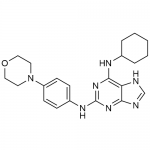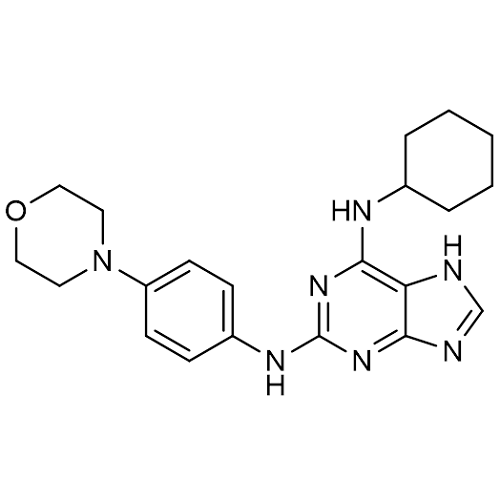| Product Name | Reversine |
| Description |
A3 adenosine receptor antagonist |
| Purity | >98% (HPLC/TLC); NMR (conforms) |
| CAS No. | 656820-32-5 |
| Molecular Formula | C21H27N7O |
| Molecular Weight | 393.5 |
| Field of Use | Not for use in humans. Not for use in diagnostics or therapeutics. For in vitro research use only. |
Properties
| Storage Temperature | -20ºC |
| Shipping Temperature | Shipped Ambient |
| Product Type | Antagonist |
| Solubility | May be dissolved in DMSO (7 mg/ml) |
| Source | Synthetic |
| Appearance | Off-white powder |
| SMILES | C1CCC(CC1)NC2=NC(=NC3=C2NC=N3)NC4=CC=C(C=C4)N5CCOCC5 |
| InChI | InChI=1S/C21H27N7O/c1-2-4-15(5-3-1)24-20-18-19(23-14-22-18)26-21(27-20)25-16-6-8-17(9-7-16)28-10-12-29-13-11-28/h6-9,14-15H,1-5,10-13H2,(H3,22,23,24,25,26,27) |
| InChIKey | ZFLJHSQHILSNCM-UHFFFAOYSA-N |
| Safety Phrases |
This product does not require a Material Safety Data Sheet under the Occupational Safety and Health Administration standard entitled "Hazard Communication" 29 CFR 1910.1200 for the United States. The product does not meet the criteria of W.H.M.I.S. classification as a controlled product. As a result, a W.H.M.I.S. Material Safety Data Sheet is not required (in Canada) for this product. |
| Cite This Product | Reversine (StressMarq Biosciences Inc., Victoria BC CANADA, Catalog # SIH-564) |
Biological Description
| Alternative Names | 2-(4-Morpholinoanilino)-6-cyclohexylaminopurine, Reversine; 656820-32-5; CHEMBL188343; CHEBI:70723; IN1127 |
| Research Areas | Autophagy, Cancer, Cancer Growth Inhibitors, Cardiac Metabolism, Cardiovascular System, Cell Signaling, G Protein Signaling, GPCR, Heart, Mesenchymal Stem Cells, mTOR Inhibitors, Stem Cells, Tumor suppressors |
| PubChem ID | 210332 |
| Scientific Background | Reversine is a small molecule that induces dedifferentiation of lineage-committed cells and inhibits aurora kinases. In neurodegenerative disease research, Reversine is used to study cell cycle re-entry in neurons, a phenomenon associated with neuronal death in Alzheimer’s and other neurodegenerative disorders. It is also employed in regenerative medicine to explore the potential of reprogramming somatic cells into neural progenitors. Reversine’s dual role in cell cycle regulation and plasticity makes it a valuable tool for investigating neuroregeneration and disease modeling. |



Reviews
There are no reviews yet.